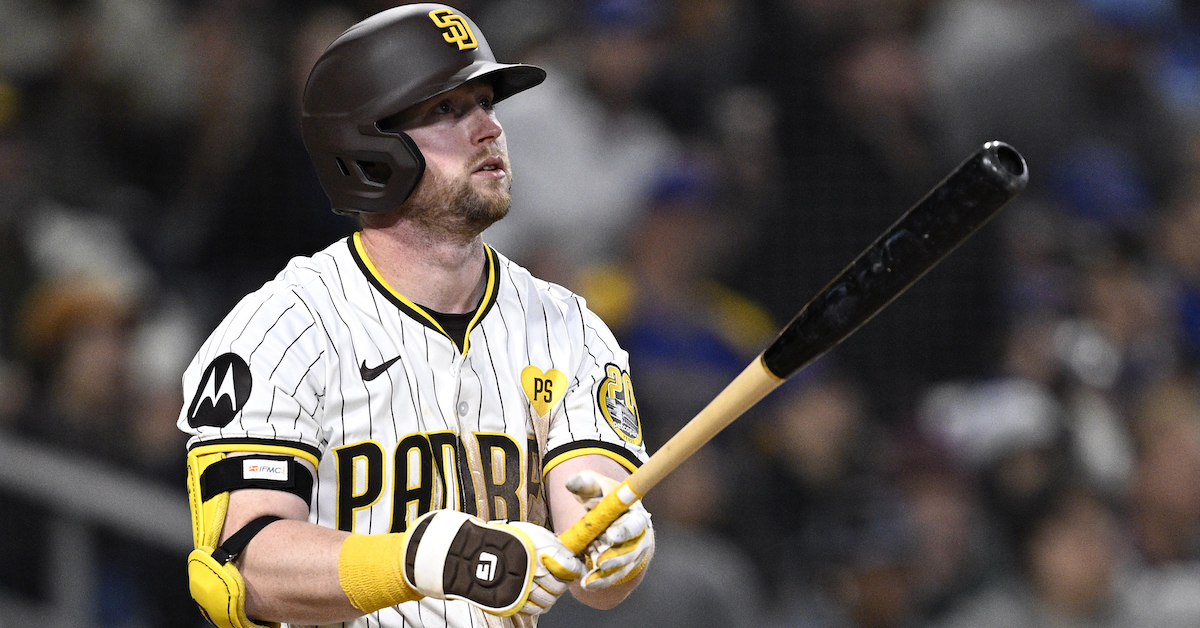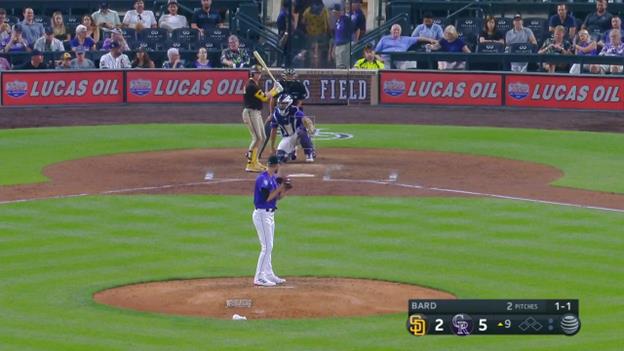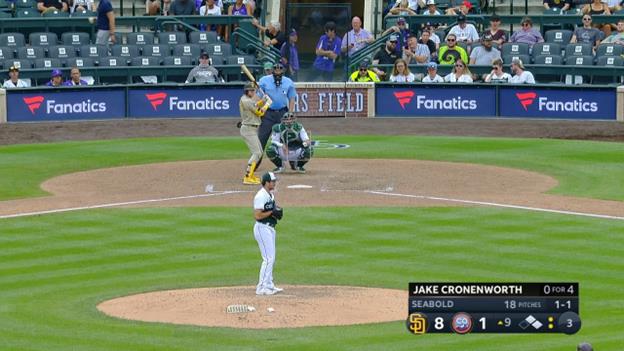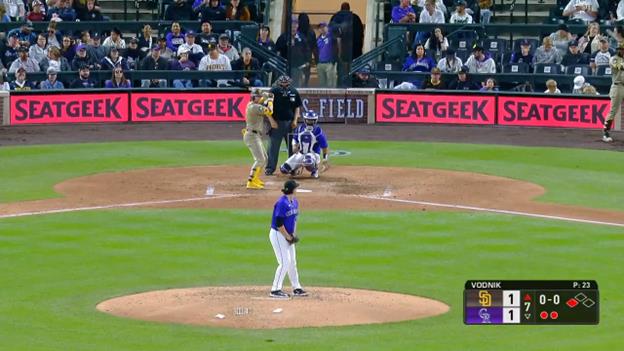
Orlando Ramirez-USA TODAY Sports
On Monday, Ben Clemens published an article containing a list of the hitters who are getting the most power from the fewest swings and misses. It’s a ratio of barrels to whiffs, which Ben — because of his inexhaustible capacity for alliteration — calls “whomps per whiff.”
One name that stood out to me was Jake Cronenworth, who came in seventh on the whomps per whiff leaderboard. I first encountered Cronenworth many years ago, when he was the Shohei Ohtani of the Big Ten, and have been mightily pleased to see him evolve from a seventh-round pick to a two-time All-Star, and a starting infielder on a Padres team that usually buys its infielders from the Rolls Royce dealership.
A year ago, Cronenworth singed a seven-year contract extension that will keep him in brown and gold into the 2030s, and then the wheels fell off.
The Padres backslid from the NLCS to around .500, and have been shedding star players ever since the death of beloved owner Peter Seidler last November. And last year, Cronenworth was one of the avatars of that decline. A line drive-spraying second baseman for the first three years of his career, he moved to first base, and rather than improving his bat to fit the offensive demands of his new position, he started hitting like a catcher. That seven-year contract, initially seen as a bargain, now looked more like a millstone.
Lucky for Cronenworth, and the Padres, he appears to be bouncing back. Cronenworth was never a superstar; over the first three seasons of his career, he averaged a wRC+ of 115, and 4.0 WAR per 162 team games. (Because Cronenworth’s best season was his 60-game rookie campaign, he has a better WAR/162 than his career high. Another fascinating statistical artifact of the pandemic.)
The Padres, presumably, would settle for that after Cronenworth hit .229/.312/.378 last year and flirted with replacement level. And sure enough, through the Padres’ first 25 games — of which Cronenworth has played 23 — he’s back to a wRC+ of 115 and on pace for 3.2 WAR. (All of the stats for this year included below are updated through the end of play Monday.)
Jake Cronenworth, Past Four Seasons
| Season |
BB% |
K% |
AVG |
OBP |
SLG |
wRC+ |
| 2021 |
8.6% |
14.0% |
.266 |
.340 |
.460 |
117 |
| 2022 |
10.2% |
19.2% |
.239 |
.332 |
.390 |
110 |
| 2023 |
8.8% |
18.6% |
.229 |
.312 |
.378 |
92 |
| 2024 |
9.8% |
15.7% |
.241 |
.330 |
.414 |
115 |
Except, what is this undersized, line drive-hitting first baseman, this Millennial Mientkewicz, doing near the top of a whomps per whiff leaderboard?
Cronenworth is whiffing less, but only just; he’s missing on 14.9% of his swings this year, down an even percentage point from 2023. Rather, Cronenworth is whomping more. A lot more.
The Underlying Jake Cronenworth, Past Four Seasons
| Season |
Barrel% |
xBA |
xSLG |
xwOBA |
xwOBACON |
HardHit% |
| 2021 |
7.2 |
.276 |
.443 |
.344 |
.365 |
35.0 |
| 2022 |
5.6 |
.221 |
.356 |
.303 |
.318 |
34.1 |
| 2023 |
4.4 |
.238 |
.370 |
.305 |
.327 |
33.2 |
| 2024 |
12.5 |
.319 |
.543 |
.406 |
.446 |
44.4 |
SOURCE: Baseball Savant
See, Cronenworth is hitting the bejeezus out of the baseball this year. Even in his better seasons, Cronenworth lived around the 20th percentile in HardHit% and around the median in barrel rate and the various expected stats. He got by on making a lot of contact and spraying the ball to all fields — he was never some Statcast darling, at least not since his extremely truncated rookie year.
I’ve got two questions: First, is he actually doing something different? And second, if so, why aren’t his results matching up to his quality of contact? This still being April, Occam’s Razor says the answer to both is “small sample,” but if I don’t at least ask, I don’t have anything to write about.
To the first question: Cronenworth does seem to be making better swing decisions. He’s always had excellent strike zone judgement, but Baseball Savant has Cronenworth’s chase rate down to 21.9%, from 26.4% last year. Meanwhile his overall swing rate is down three percentage points while his in-zone swing rate is up seven-tenths of a point. So far, so good.
Cronenworth has also changed his batting stance. Here he is in 2021, when his xwOBA was .344, his best mark for a full season. (All three of these screencaps are from games at Coors Field, which has an exquisite dead-on center field camera angle.)

Hands low and away from the body, bat at 11 o’clock, neutral stance. Looks like offense to me.
Let’s check in two years later, from this game in 2023.

Cronenworth’s legs and bat angle are about the same, but he’s moved his hands up and in and his upper body is leaned back. It looks like he’s doing the Bernie, and I promise it’s even more exaggerated on broadcasts from Petco Park.
Fast forward to 2024.

Here, you can see that Cronenworth has clearly either been to the chiropractor or made a conscious effort to stand more upright, perhaps even leaning forward ever so slightly. Also, notice how he’s holding his bat. I know it’s a bit hard to see here, because after using blond wood in the previous screencaps, Cronenworth has gone to a black-over-blond lacquer job, which makes his bat look like the world’s largest chocolate Pocky. More to the point, the darker bat blends in with the stands and the railing behind home plate, but make no mistake, his hands are way higher and his bat — previously held at about 11 o’clock from the pitcher’s vantage point — is now more like a quarter to 10.
Clearly it’s working. Cronenworth is whomping three times as frequently as he did last year; and his HardHit% is up by a third. All with zero deleterious effects on his contact ability or walk rate.
And yet, he’s underperforming his exit velo and launch angle numbers by close to 80 points of batting average and almost 130 points of slugging percentage. Is he just running into outs and bound for an enormous May? Perhaps. But I’d like to propose an alternative hypothesis. Let’s look at where Cronenworth is hitting the ball.
The Spray Charts of Jake Cronenworth, Past Four Seasons
| Season |
LD%+ |
GB%+ |
FB%+ |
Pull%+ |
Cent%+ |
Oppo%+ |
| 2021 |
104 |
99 |
99 |
85 |
110 |
110 |
| 2022 |
84 |
82 |
130 |
83 |
106 |
121 |
| 2023 |
111 |
87 |
110 |
88 |
107 |
110 |
| 2024 |
134 |
91 |
93 |
72 |
134 |
98 |
The first thing I noticed this season is that Cronenworth is 1) hitting more line drives, which I think we can all agree is an unalloyed good, and 2) hitting to a more or less even groundball-to-fly ball ratio, after two seasons of putting the ball in the air more. In general, hitting the ball in the air leads to more home runs, but that’s more true the more you pull the ball.
Cronenworth has never been a pull hitter, and he’s never been less of a pull hitter than he has been so far in 2024. For someone like him, especially an above-average runner who hits left-handed, it makes sense to try to hit more line drives. I’m not saying he needs to turn into Tim Anderson and just beat the ball into the dirt all the time, but a GB/FB ratio of about 1.2 might be more profitable than a ratio of 0.8, all things considered.
Almost a year ago to the day, I examined the misfortunes of Orioles first baseman Ryan Mountcastle, who was underperforming his expected stats and suffering through BABIP hell at the time. I’ll restate what I said then: xwOBA and its brothers account for exit velo and launch angle, but not batted ball direction, and batted ball direction matters quite a bit.
Leaguewide wOBA by Trajectory
| League |
Groundball |
Line Drive |
Fly Ball |
| Pull |
.191 |
.739 |
.729 |
| Center |
.227 |
.669 |
.230 |
| Oppo |
.427 |
.672 |
.171 |
In general, line drives are the best kind of hit no matter in what direction they go. But you want to hit the ball to the pull side in the air — think of any beefy left-handed hitter clearing his hips and yanking the ball down the line and into the second deck — and to the opposite field on the ground.
Why are opposite-field grounders so useful? Maybe because pull-side grounders tend to go into whatever shade or shift the defense puts on, not that that would be a problem for Cronenworth, who doesn’t pull the ball much. Or because, paradoxically, a lot of hard grounders turn into easy outs, while a swinging bunt off the end of a lefty’s bat can roll up the line and into the hands of a third baseman who’s resigned to being too late to make the out. Who knows?
And here’s the raw totals for each direction of batted ball for Cronenworth in 2021, 2023, and so far in 2024. Remember, you want to hit the ball the other way on the ground and pull the ball in the air.
Cronenworth’s Batted Ball Totals
| 2021 |
Groundball |
Line Drive |
Fly Ball |
| Pull |
92 |
31 |
43 |
| Center |
85 |
40 |
59 |
| Oppo |
25 |
33 |
71 |
| Pull |
67 |
29 |
37 |
| Center |
51 |
29 |
54 |
| Oppo |
16 |
22 |
53 |
| Pull |
10 |
7 |
4 |
| Center |
15 |
7 |
12 |
| Oppo |
4 |
5 |
8 |
And Cronenworth is doing the complete opposite. He always has to some extent, but this year, half of his fly balls have gone to center. That’s bad if for no other reason than the fence is something like 70 feet farther away in center field than it is down the lines. That’s why Cronenworth has hit 16 balls 325 feet or more this year, and 12 of them have gone for outs. His xSLG on those balls is 1.514; his actual SLG is just .875.
When we’re dealing with batted ball totals in the mid-double digits, there are probably some sample size kinks that’ll work themselves out by October. But Cronenworth, ironically, is being betrayed by his ability to hit to all fields. He’s getting a lot of whomp for his whiff, but tragically little bang for his whomp.
Source
https://blogs.fangraphs.com/jake-cronenworth-has-bounced-back-he-should-be-bouncing-back-even-more/
 Backyard GrillingWeekend WarriorsAdvice from DadBeard GroomingTV Shows for Guys4x4 Off-Road CarsMens FashionSports NewsAncient Archeology World NewsPrivacy PolicyTerms And Conditions
Backyard GrillingWeekend WarriorsAdvice from DadBeard GroomingTV Shows for Guys4x4 Off-Road CarsMens FashionSports NewsAncient Archeology World NewsPrivacy PolicyTerms And Conditions
